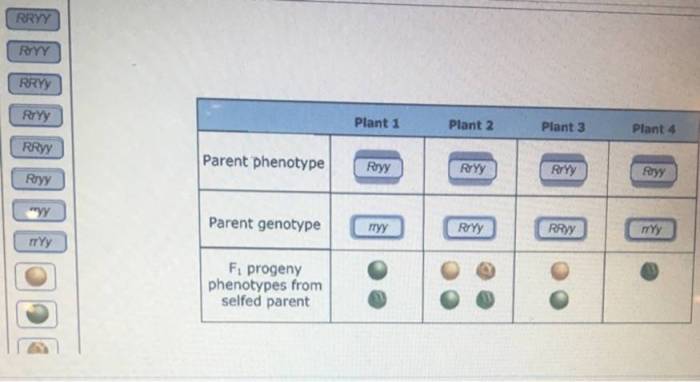Deducing phenotypes and genotypes of selfed parents – Deduction of phenotypes and genotypes of selfed parents is a fundamental aspect of genetic analysis. It allows researchers to understand the inheritance patterns and genetic makeup of individuals resulting from self-fertilization.
Selfing, the process of self-fertilization, leads to offspring that are homozygous for all loci, making it an ideal system for studying the relationship between genotype and phenotype. By analyzing the phenotypes and genotypes of selfed offspring, scientists can gain insights into the genetic basis of traits, identify recessive alleles, and study the effects of inbreeding.
Defining Selfed Parents and their Offspring
Selfing, or self-fertilization, occurs when an individual reproduces with itself, resulting in offspring that are genetically identical to the parent. This process has significant implications for genetic inheritance and the characteristics of the resulting offspring.
Selfed parents have identical genotypes, as they have inherited all their genetic material from a single source. Consequently, their offspring also have identical genotypes, exhibiting a homozygous genetic makeup. Homozygosity means that individuals possess two identical alleles for a particular gene, making them true-breeding for that trait.
Deduction of Phenotypes

Deduction of phenotypes from selfed offspring relies on the principle of phenotypic uniformity. As selfed offspring have identical genotypes, they exhibit uniform phenotypes, meaning they all express the same observable characteristics.
By observing the phenotypes of selfed offspring, it is possible to deduce the phenotype of the parent. For example, if all offspring of a selfed plant have red flowers, it can be inferred that the parent plant also had red flowers, as this trait is homozygous.
| Phenotype | Genotype | Supporting Evidence |
|---|---|---|
| Red flowers | RR | All offspring have red flowers, indicating homozygosity for the red flower allele. |
| White flowers | WW | All offspring have white flowers, indicating homozygosity for the white flower allele. |
| Intermediate flower color | RW | Offspring exhibit a blend of red and white flowers, indicating heterozygosity for the flower color allele. |
Deduction of Genotypes

Genotype deduction in selfed parents and their offspring involves applying Mendelian inheritance principles. Mendelian inheritance dictates that alleles segregate during meiosis, resulting in gametes (pollen and eggs) that carry only one allele for each gene.
When self-fertilization occurs, each gamete fuses with an identical gamete, resulting in offspring with homozygous genotypes. The genotype of the parent can be deduced by observing the phenotypic uniformity of the offspring.
For instance, if all offspring of a selfed pea plant are tall, it can be inferred that the parent plant was homozygous dominant (TT) for the tall allele. Alternatively, if all offspring are short, the parent plant was homozygous recessive (tt) for the short allele.
The following flowchart illustrates the steps involved in genotype deduction:
- Observe the phenotype of selfed offspring.
- Determine the possible genotypes that could produce the observed phenotype.
- Consider the principle of phenotypic uniformity to infer the genotype of the parent.
Challenges and Limitations: Deducing Phenotypes And Genotypes Of Selfed Parents

Deduction of phenotypes and genotypes from selfed parents can be challenging due to several factors:
- Environmental influences can affect phenotype expression, making it difficult to determine the underlying genotype.
- Genetic mutations can introduce new alleles or alter existing ones, leading to unexpected phenotypes.
- Incomplete dominance or codominance can result in offspring with intermediate phenotypes, making genotype deduction more complex.
To improve the accuracy of deductions, it is essential to:
- Consider environmental factors and their potential impact on phenotype expression.
- Screen for genetic mutations that may alter expected phenotypic outcomes.
- Conduct multiple crosses to confirm genotype deductions.
Applications of Deduction

Deduction of phenotypes and genotypes in selfed parents has numerous practical applications:
| Application | Benefits | Examples |
|---|---|---|
| Agriculture | – Develop homozygous lines for breeding programs.
|
– Selfing in wheat to create pure-breeding lines for disease resistance.
|
| Conservation | – Preserve genetic diversity in endangered species.
|
– Selfing in captive breeding programs for cheetahs to maintain genetic diversity.
|
| Medical Genetics | – Identify carriers of genetic disorders.
|
– Selfing in mice to create animal models for human genetic diseases.
|
FAQ Overview
What is the difference between a phenotype and a genotype?
A phenotype is the observable characteristics of an individual, while a genotype is the genetic makeup of an individual.
How can I deduce the genotype of a selfed parent from its offspring?
By observing the phenotypes of the offspring, you can infer the genotype of the parent. For example, if all the offspring of a selfed parent have a dominant phenotype, then the parent must be homozygous dominant for that trait.
What are the challenges of deducing phenotypes and genotypes from selfed parents?
Challenges include environmental influences that can affect the phenotype, genetic mutations that can alter the genotype, and the limited number of offspring available for analysis.